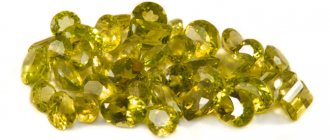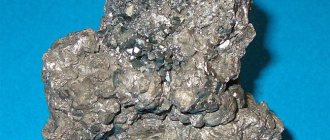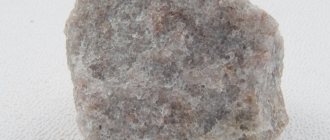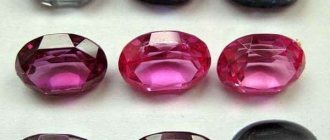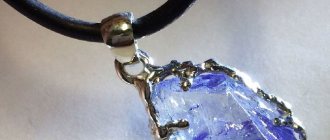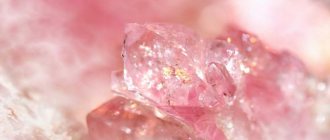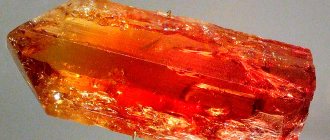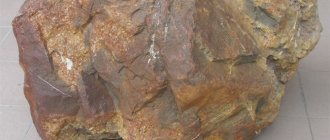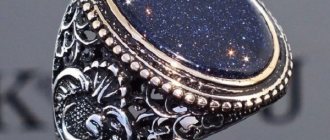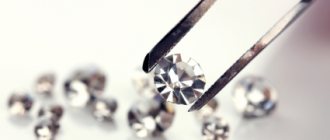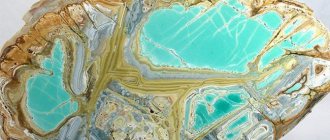| Category | Carbonates (minerals) |
| Title in English | Aragonite |
| Formula | CaCO3 |
| Group | Group of calcium carbonate polymorphs |
| Color | White, Colorless, Grey, Blue, Green, Red |
| Stroke color | White |
| Shine | Glass |
| Transparency | Transparent, Translucent |
| singonia | Rhombic |
| Hardness | 3,5 — 4 |
| Cleavage | Imperfect |
| Density, g/cm³ | 2,93 |
| Kink | Uneven |
| origin of name | It is named after the place where it was first found. Namely, in the Italian province of Aragon. |
| Morphology | Contains individual short-plasma and long-prismatic crystals. Also, there are needle-shaped, dipyramidal, thick-tabular crystals. |
Aragonite is a type of calcium carbonate. The mineral differs from the same composition as calcite in the structure of its crystal lattice and, accordingly, in its properties. Aragonite crystals are found in prismatic, columnar, tabular, needle-shaped and spear-shaped. They also form intergrowths of a wide variety of shapes. In addition, aragonite is a component of the mother-of-pearl layer of mollusk shells and the exoskeleton of coral.
Aragonite deposits
Aragonite is very widespread on our planet.
The largest amount of the mineral is mined on the European continent, since the demand for it is highest here. There are known deposits in the Alpine mountains where high-quality aragonites are mined. — Advertising —
In addition, large deposits of stone are “hidden” in a strip of the oceanic shelf zone. In the area of surf and changeable currents, aragonite intergrowths become so-called oolites (egg-shaped pebbles).
History and deposits of the mineral
Aragonite was first discovered in 1797 in Spain in the city of Aragon. In honor of the city, the gem acquired its mineralogical name.
According to the ancient Spanish legend, aragonite is the frozen tears of a girl whose parents did not give their blessing to marry the young man she loved. The girl was imprisoned, far from her chosen one, shedding many bitter tears.
Interesting fact: the mineral is formed at low temperatures by hydrothermal sedimentation. In addition, it is formed in basalt voids and hydrocarbonate hot springs.
Today the largest deposits of aragonite include:
- Spain;
- Czech Republic;
- Germany;
- France;
- Austria;
- Japan;
- USA;
- Kyrgyzstan;
- Turkmenistan.
In Russia, gems are mined:
- in the Southern Urals;
- Taimyr.
Please see a little information about the mineral:
History of aragonite
Aragonites became known as precious stones relatively recently.
Although their age is approaching hundreds of millions of years, after which the stone turns into calcite. They began to distinguish aragonite from the latter only in the 18th century, at which time they gave it a name consonant with Spanish Aragonia, where they first became interested in this mineral. At the same time, the ability of aragonites to transform into calcites was also noticed. In order to improve the quality of the stone, stone cutters tried to heat it, but this did not lead to the desired result. On the contrary, the aragonite crumbled into fine calcite powder. This phenomenon is associated with an increase in the volume of the sample and the gradual detachment of the upper particles.
Aragonite is also known under other names, including: mother of pearl, iron flower, sparkling or pea stone, conchite. Natural specimens of spherical shape are called oolites or oolitic stones.
Stone care
It is worth remembering that this mineral is very fragile. It is easy to scratch or even break. That is why, if it is a ring or bracelet, then when entering public transport the best solution would be to remove the jewelry or ensure its safety.
At home, you also can’t let your guard down.
Helpful information
You should not wash dishes or clean without first removing jewelry containing aragonite. It is best to store it in a box or tight bag separate from other jewelry. Otherwise, the jewelry will either be scratched or lose its integrity.
The stone should not be stored near heating devices. This directly shortens the “life” of the jewelry. When cleaning jewelry, do not use strong reagents. If you use hydrochloric acid, the mineral will literally boil.
Physico-chemical characteristics of aragonite
— Advertising —
Aragonites consist of calcium carbonate; they contain magnesium, iron, zinc, and lead as impurities. The crystals are colorless or white, grayish, yellowish or reddish in color with a greasy or glassy sheen.
They are characterized by a rhombic system, transparency or translucency, imperfect cleavage, and conchoidal fracture. Hardness on the Mohs scale is 3.5-4. Density 2.9-3.0 g/cm3.
Aragonite, which is mined in the territory of karst caves, forms intergrowths in the form of a sinter crust with protruding crystals, needle-shaped spherical formations, and radial-radiant intergrowths. Sometimes spherulites are mined.
Mother-of-pearl is formed from a thin layer of aragonite, which alternates with a transparent layer of solid organic substances. Thus, each pearl is a kind of “layer cake”, where the filling is aragonite.
What is a mineral
The mineral aragonite is a modification of calcium carbonate. Its chemical formula is similar to calcite, and the exact composition is determined by impurities. For example, the dominance of iron creates a yellow mineral. Zinc provides a red-brown-violet color palette.
The mother-of-pearl layer of sea shell valves is made of aragonite. It builds up in layers, forming a pearl inside the mollusk.
The origin of the mineral is recognized by its outline: round or other smooth samples are a product of the sea. Sharp crystals, hexagonal prisms, “twigs”, “flowers” are formed in caves, like deposits of carbonate dissolved in water. They are also known as stalactites.
Aragonite crystals
The fragility of the mineral was noted by the first stone cutters. Trying to improve aesthetic conditions, they heated aragonite. But instead of improvement, they received calcite powder: the increase in volume destroyed the crystalline structure.
| Formula | CaCO3 |
| Color | Colorless, white, gray, yellowish, reddish |
| Stroke color | White |
| Shine | Glass |
| Transparency | Transparent, translucent |
| Hardness | 3,5—4 |
| Cleavage | Imperfect by {010} |
| Kink | Conchoidal; fragile |
| Density | 2.93 g/cm³ |
| singonia | Rhombic (planaxial) |
Types of aragonite
Depending on the content of certain impurities in the composition of the mineral, as well as on its form, several types of aragonite are distinguished:
- Tarnovycytes - distinguished by prismatic hexagonal crystals of a warm brownish-violet hue. This variety of aragonite is rich in lead.
- Nicholsonites - contain zinc inclusions in their composition, are distinguished by red-brown shades interspersed with pure purple color. In general, this variety is characterized by the most varied color range of all aragonites.
- Sprudelsteins or pea stones, also known as cave pearls and marble onyx. They are formed during the processes of precipitation of calcium compounds from a natural solution, and are distinguished by a variety of shapes and sizes of intergrowths and drusen. It is polished sprudelsteins that are often used as jewelry inserts and material for beads and bracelets.
- “Iron flower” is an unusually shaped variety of mineral, in which oblong mineral formations are intertwined into bizarre “inflorescences”.
- Needle-shaped crystals are transparent prisms or elongated needles.
- Helictite is a coral-like aggregate that is common in karst caves and beautifully branches to form complex structures.
- Pisolite is a rounded stone the size of a pea (about 2 mm), also known as the “pearl of caves.”
Price
According to the jewelry classification, aragonite is a semi-precious (lower segment) or ornamental stone. This circumstance, plus its prevalence and ease of extraction, determined the availability of prices for the mineral (rubles):
- crystals (7.5x6x5.5 cm) – 2,550-2,800;
- ball (4.8-6.3 cm) – 1,700 – 3,560;
- egg (3x4-4x5 cm) – 820-1,240;
- white tumbling (2–3 cm) – 240–290;
- crystal intergrowths (3–4 cm) – 380–650.
The price is also determined by the deposit and type of mineral. For example, a sample of sky-blue vanadium aragonite from Morocco (size S, that is, 5–7 cm and weighing 14 g) costs RUR 5,890.
Average cost of products (RUB):
- earrings – 600–780;
- rosary (onyx+aragonite) – 1,970;
- white bracelet (diameter 14 mm, Mexico) – 1,090;
- white beads (14 mm, Mexico) – 2,490;
- silver ring – 860–2360;
- gold ring with aragonite – 7,900-21,300.
Ring with aragonite
The price of jewelry made of aragonite depends more on the material of the frame: the cost of gold and silver accessories with similar inserts differs by an order of magnitude.
Magical properties of aragonite
Decorations and interior items made of aragonite help stop disputes between husband and wife.
They are also able to optimize the difficult relationships characteristic of mother-in-law and son-in-law, daughter-in-law and mother-in-law, parents and children. Aragonite “smoothes out” all the rough edges and helps representatives of different generations achieve mutual understanding. Aragonites also attract prosperity and prosperity to the home of their owners. It is believed that in their presence, the material condition always improves.
And aragonite miraculously helps in housekeeping for everyone who does not really like this business. The mineral adds strength, fights laziness, and gives inspiration and ingenuity to perform even the most boring housework, which a person begins to do perfectly.
Who is aragonite suitable for according to their zodiac sign?
Aragonite is considered one of the friendliest minerals and suits almost all zodiac signs:
- It balances representatives of the fire element, calms hot impulses, helps them find peace and find devoted partners.
- For water signs, aragonite evens out the emotional background and helps them experience love dramas more smoothly.
- It gives charm, lightness and purity to earthly representatives, helps soften “angular” character traits, reveals cordiality and kindness.
- For air signs, aragonite brings peace and tranquility, helps to “ground” without hardening, helps to find mutual understanding, establishes connections with the “right” people, and protects the warmth of the family hearth.
Some astrologers especially recommend wearing aragonite for Cancers and Virgos, others mention the sign of Capricorn. It is believed that the constellation Scorpio and the strong influence of Pluto interact poorly with this peace-loving stone.
Speaking of gender, aragonite has a deep feminine element and is associated with feminine sensuality, empathy, innocence and maternal care. Nevertheless, it is also suitable for men, helping to develop understanding, reveal warmth, and protect family wealth.
It’s still too early for children to wear a stone, but they can decorate their family home with aragonite products.
To establish contact with children, parents need to wear the stone.
Healing properties of aragonite
In lithotherapy, aragonite is known as a stimulator of sexual function in both sexes.
The stone also has a positive effect on the state of the human nervous system, helps get rid of fears and feelings of anxiety, enslavement, irritability and anger, and quickly restores the strength of its owner. Aragonite applications are used to treat various skin diseases. And the water that has been filtered through aragonite chips becomes healing. Such sources include those located in Karlovy Vary and Baden-Baden.
A good effect of aragonites on mature people has been noticed. Thus, they help alleviate the symptoms of menopause and reduce senile dementia.
Medicinal use
The healing properties of aragonite are extensive. This stone is called a healing crystal. And if the mineral is used for therapy, then it must be stored from the effects of negative reactions. For aragonite to help, it must be placed in a room where the patient is constantly present, or always carried with you. The crystal can help reduce temperature and inflammation, relieves fever.
Lithotherapists claim that aragonite helps with sexual dysfunction: it increases sexual activity, treats impotence, various diseases of the reproductive organs and frigidity in both sexes. The mineral also has a calming effect on the nervous system, helps to fall asleep, relieves unreasonable fears, reduces irritation, anger, and fatigue.
Improves hair growth and stops hair loss. Normalizes blood circulation in the extremities, warms them, relieves muscle spasms and twitching. Aragonite is excellent in the treatment of skin diseases - allergic, infectious, nervous.
Aragonite colors
Aragonite specimens are generally colorless or white.
If the mineral contains any impurities, a variety of tones appear in it: from purple, blue and gray to orange, red, light green. Blue-green aragonites are called iglites, blue ones are called tseringites. Gems can be either transparent, semi- or opaque.
How to distinguish a real stone from an artificial fake
There are several proven ways to distinguish natural stone from a fake:
- Warmth. Natural stone is always somewhat cold. If you apply it to your lips for a few seconds, natural aragonite will remain cool, but glass or plastic will be warmed by the warmth of your breath;
- Aurally. If you tap a natural stone on glass, you will get a characteristic sound, which can easily be used to identify a fake;
- By weight. Natural stone is always heavier than plastic, ceramic and glass of the same size.
- Photoluminescence. When irradiated with ultraviolet light, aragonite emits an orange-red glow.
Also read: Uvarovite - the emerald beauty of the Urals
The best way to protect yourself from counterfeits is to buy a gem from a reliable seller who has the appropriate documents and certificates.
How to care for aragonite
Caring for aragonite and products made with it should be careful and careful, since the mineral is quite fragile and deteriorates when exposed to high temperatures and frequent exposure to bright sun.
It is recommended to store aragonite jewelry in tightly closed boxes in soft fabric. Clean them with a damp cloth.
Rules for wearing and care
Aragonite is delicate: it is afraid of mechanical influences, aggressive household chemicals, direct sunlight, and heat.
It needs careful care:
- Dust is wiped off with a dry soft cloth. Serious stains can be easily cleaned with soapy water and a cloth (you can pre-soak for a few minutes and rub). Then rinse clean. When cleaning jewelry frames, protect the inserts or make sure that the cleaning agent does not get on them.
- Jewelry is removed before washing dishes and similar household chores, going to the pool, sauna, or the beach.
- Put on rings, necklaces, earrings after applying makeup, when cream, varnish, and other cosmetic substances have been absorbed or dried.
- Jewelry is stored in a dark, tightly closed box, lined with soft fabric on the inside. It is better to select a separate box or cell.
Figurines or other aragonite specimens should not be placed near radiators, stoves, or other heat sources. The heat will cause the mineral to crumble or turn into ordinary calcite. His magic will be gone.
Prices for aragonite products
In general, prices for aragonites, due to their widespread occurrence, are not very high. For example, a polished plate weighing 100 g is valued at about $10. And picturesque aragonite deposits, which are purchased for mineralogical collections, are estimated at 5-7 dollars. The cost of jewelry with aragonite inserts, depending on the cutting material and the work of the craftsman, ranges from $40-500.
Where is the mineral used?
The characteristic of the mineral as fragile and difficult to process did not become an obstacle to its use. Colorfully rich aragonite is in demand by jewelers, stone-cutters, and collectors.
Everyone has a reason to love the mineral aragonite:
- Jewelers produce an assortment of jewelry, including bracelets and ring inserts. The frame chosen is noble: silver, gold, platinum. Blue aragonite is often indistinguishable from turquoise, and well-polished polka dots imitate elite pearls.
- Stone cutters carve balls, pyramids, and other figures. There are larger things - boxes, desk writing instruments, photo frames.
- Each specimen makes collectors happy: the uniqueness of color and shape makes it unique.
Pendant with aragonite
At the same time, the price of the mineral is affordable, even from distant corners of the planet.
Interesting facts about aragonite:
- Aragonite talismans are used to maintain family unity. It is believed that such an amulet can discourage a person from romantic interests on the side, gambling, friendly feasts, addiction to drinking and everything that can destroy a happy family life.
- The hexagonal aragonite is a symbol of the Star of David and the seal of King Solomon. In magical rituals, the gem is often used to restore strength. In addition, aragonite is compared to a soul reaching out to the universe. Just as its direct rays are directed to the sides, so the soul, during growth and development, strengthens and learns to cope with difficulties. With the help of aragonite, its owner becomes self-disciplined.
- Aragonite is an unstable phase of calcium carbonate. Over 10-100 million years, it gradually turns into calcite. At the same time, the volume of the stone increases. And if a sample of aragonite is heated to 400°C, then this transition occurs right before our eyes, and the durable stone crumbles into fine powder.
The magical power of the stone
Aragonite is considered a family stone. It protects home peace and smoothes out conflicts between spouses. For lonely people, aragonite will be burdensome and make them sad. You can decorate your home with twigs, a box or any craft made from aragonite.
For family
According to Feng Shui, an aragonite figurine attracts good luck and prosperity to the home. To do this, it is recommended to place the mineral in a prominent place. Its energy helps in purchasing housing or starting your own business.
The stone must “settle in” in the house for the magical powers to begin to work. You can place souvenirs in all rooms. If the stone is in the bedroom, it helps to conceive a child and strengthen sexual relationships.
For people young and old
A pendant or amulet with aragonite will help a teenager overcome the difficulties of adolescence. It helps older people maintain memory and a sober mind until old age.
The presence of the stone helps you concentrate your attention and make the right decision with a clear head.
A good gift for newlyweds would be a talisman with a blue mineral.
